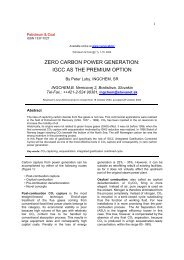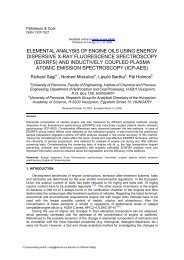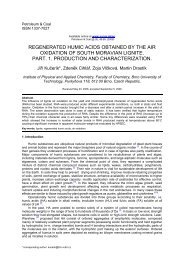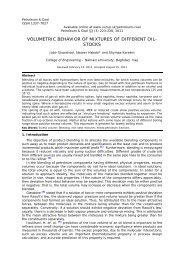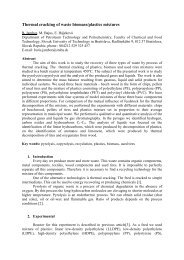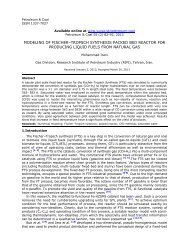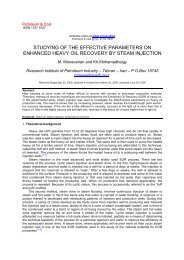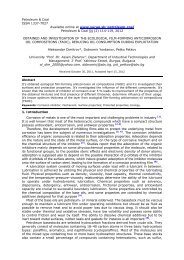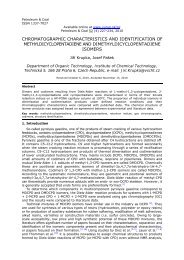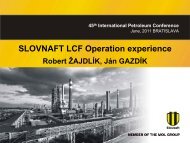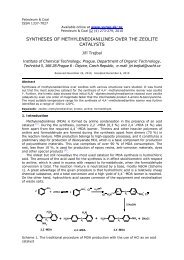AN INVESTIGATION OF THE EFFECT OF BUBBLE DIAMETER ON ...
AN INVESTIGATION OF THE EFFECT OF BUBBLE DIAMETER ON ...
AN INVESTIGATION OF THE EFFECT OF BUBBLE DIAMETER ON ...
Create successful ePaper yourself
Turn your PDF publications into a flip-book with our unique Google optimized e-Paper software.
Petroleum & CoalISSN 1337-7027Available online at www.vurup.sk/pcPetroleum & Coal 50 (1), 11-22, 2008<strong>AN</strong> <strong>INVESTIGATI<strong>ON</strong></strong> <strong>OF</strong> <strong>THE</strong> <strong>EFFECT</strong> <strong>OF</strong> <strong>BUBBLE</strong><strong>DIAMETER</strong> <strong>ON</strong> <strong>THE</strong> PERFORM<strong>AN</strong>CE <strong>OF</strong> GAS-SOLIDFLUIDIZED BED REACTOR <strong>AN</strong>D TWO-PHASE MODELING<strong>OF</strong> BUBBLING FLUIDIZED BED REACTOR IN MELAMINEPRODUCTI<strong>ON</strong>Amir Farshi, Houman Javaherizadeh, M.A. Hamzavi –AbediEngineering Development of Chemical Processes Research Division, Research Instituteof Petroleum Industry, Tehran, Iran, farshia@ripi.irReceived December 2, 2007, accepted March 15, 2008AbstractBubble diameter is an important parameter in the modeling of gas-solid fluidized bed reactor and plays an importantrole in the performance of the fluidized bed reactor. Determination of the actual bubble diameter in the fluidizedbed is very important. Bubble diameter starts at the initial bubble diameter ( Db0) and grows by coalescence andsplitting phenomena, until it reaches the stable bubble diameter at the bed.Variation of bubble diameter with bed height has been expressed as linear, exponential, and fractionalrelationships. The linear relationship of Yasui et al. [34] predicts the highest value, while the relationship of Park et al. [21]predicts the lowest value and the relationship of Mori and Wen [19] yields an intermediate value. Computation of meanvalue of bubble diameter is especially important, because it is usually necessary in relationships for determinationof bubble velocity. For investigation of the performance of fluidized bed reactor, the two-phase model of Werther [31,32] wasused. The results of modeling, including variations of raw material conversion fraction with gas velocity weredrawn for various equations of bubble diameter and were compared to experimental conversion fractions.The results show that the diameter relationships of Mori and Wen [19] and Rowe [23] provide a better fit of data thanother equations. For this reason, the equations of Mori and Wen [19] and Rowe [23] are the best relationships forestimation of bubble diameter.Other relationships, like Darton et al. [5] provide a suitable estimation of bubble diameter in some situations. On the otherhand, some equations, like Geldart [8] and Werther [14] do not yield appropriate predictions for bubble diameter.Keywords: Bubble diameter; Fluidized bed; Modeling; Two-phase; Bubble coalescence; Bubble splitting1. IntroductionThe velocity of mass transport in the bed is a function of bubble size. In general, velocity oftransfer between different phases (bubble, cloud, wake, and emulsion) has an important effect on theperformance of fluidized bed reactor. For this reason, accurate determination of bubble diameter andits variations with operational conditions and reactor geometry (e.g., diameter and height) is of utmostimportance.In modeling of fluidized bed with constant bubble diameter, the bubble diameter is considered asa parameter of the model. The effective size of bubbles in the bed is determined from experimentaldata. In this way, it is attempted to fit the experimental conversion fraction with simulated conversionfraction.Generally, the constant bubble diameter model suffers serious drawbacks for reactor design,scale-up, and optimization, because it uses the average bubble diameter and does not take intoaccount the correlation of bubble diameter with bed height and operational circumstances.
1.1. Bubble Diameter Equations in Gas-Solid Fluidized Bed ReactorSo far, various equations have been proposed for describing variations of bubble diameterthrough coalescence as a function of apparent gas velocity, design of distributor, and bed height.These equations include linear and exponential functions of bed height ( h ). These equations havebeen proposed by Yasui et al. [34] , Kato and Wen [13] , [21] Park et al., Geldart [8] , Whitehead et al. [33] ,Rowe et al. [23] , Darton et al. [5 ], Mori and Wen [19] , and Werther [14] . Some of these formulas have beenused for fluidized bed; for example, some researchers, including Toor and Calderbank [29] , Kato andWen [13] , Mori and Wen [19] , and Peters et al. [22 ], have used these equations in their papers. Thesemodels have been used primarily for analysis of experimental results and investigation of the effect ofoperational conditions and model parameters on the performance of fluidized bed. Freyer and Potter [7]conducted studies with the two-phase model of Orcutt et al. [20] with plug flow for emulsion (dense)phase using the equations of Kato and Wen [13] for bubble growth.1.1.1. Frequency of Bubble Coalescence and Splitting in Gas-Solid Fluidized Bed [11]Two phenomena play a part in the change of bubble diameter: coalescence and splitting. Therelative importance of each phenomenon differs for various particles. For large particles of Geldart B,D categories, coalescence causes the change in diameter, while for tiny particles, in addition tocoalescence, splitting is also influential in bubble diameter change. Bubble coalescence follows theideal fluid dynamics, and depends on the diameter of involved bubbles and their elevation (Grace andClift [4] ). On the other hand, frequency of splitting does not depend on the bubble diameter, but isdependent on the size of the particles. Toei et al. [27] showed that, according to their study findings,*−0.6fSis proportional to dp . Tone et al. [28] showed that bubble diameter decreases with increasing*temperature. This shows that fSis dependent upon the fluid viscosity. Therefore, based on the workby Horio and Nonaka [11], we can express the frequency of bubble splitting with the following formula:*− fS1fS= fSU ( = 1 ≈ 1.2)0 mffS(1)1The effective coalescence frequency is expressed by the following equation:neff= nC− nS(2)where neffis effective coalescence frequency, nCis coalescence frequency, and nSis bubblesplitting frequency. In this equation, n is the frequency in relation with unit height, and it is correlatedto bubble production frequency ( fb) according to the following relationship:− dfbneff= nC− nS=(3)dzSince bubble production frequency ( fb) is related to bubble diameter ( Db) byA( U −UD)fb=, (4)⎛ π ⎞ 3⎜ ⎟( Db)⎝ 6 ⎠( nC − n S) is related to bubble diameter ( Db) by4dDbπDb= ( nC− nS) (5)dz 18 A( U −U)In these equations, UDhas been considered to include the effect of dense phase expansion inbeds with small particles. For beds with large particles, UDis equal to , while for tiny particles,UDthe ratio varies between 1 and 4. Anyway, for small particles, the practical gas velocity is greaterUmfthan the value of Umf, so assuming UD= Umfwill not create a large error.For particles in B, D categories of Geldart classification, where frequency of bubble splitting ( nS)is insignificant, Equation (5) for computation of coalescence frequency is reduced to the following equation:DUmf
( U −U)18 ⎛ ⎞DA ⎛ dDb⎞n =⎜⎟C ⎜ ⎟ (6)4π ⎝ Db⎠⎝dz ⎠The splitting frequency per unit height is expressed by the following simple formula:n = (number of bubble splitting with unit bubble rise)× (bubble production frequency)Sf *SUbrf= (7)By substituting Equation (4) in (7) and using U = 0. 711 gD , we havenS1.5br( U −U)D3bDDb2rf0.711*S= (8)Equilibrium bubble diameter ( Dbe) is calculated by assuming the coalescence and splittingfrequencies to be equal (n = n ).CS1.1.2. Bubble Diameter Equations in Gas-Solid Fluidized Bed Reactor for Particles in Geldart B,D CategoriesYasui et al. [34] were the first researchers to propose a particle growth formula in whichcoalescence was taken into account. Their equation is0.63⎛ U ⎞Db= 0.16ρ pd⎜p−1⎟h (9)U⎝ mf ⎠Kato and Wen [13] (Kobayashi [15] ) entered the initial bubble diameter in the equation for bubblediameter:⎛ U ⎞Db= 0.14ρ pd⎜ ⎟ph + Db0(10)U⎝ f ⎠Geldart [8] expressed the linear correlation of bubble diameter as follows:0.94Db= 2.05( U −Umf) h + Db0(11)Rowe et al. [19 ] and Darton et al. [5] proposed power functions for bubble diameter:0.40.80.54( U −Umf) ( h + 4 A)Db=0.2g(Darton et al.) (12)⎛ ⎞⎜UD⎟b= A1+ B1h+ C1+⎝Umf⎠⎛ ⎞ ⎛ ⎞⎜U⎟ ⎜UD ⎟1h+ E1⎝Umf⎠ ⎝Umf⎠(Rowe et al.) (13)where A1, B1, C1, D1, and E1are constants of the equation.Rowe et al. [23 ] also proposed this equation for bubble diameter:0.50.75( U −Umf) ( h − h0)Db= (14)0.25gThe value of h0depends on the type of plate distributor. For porous distributor, the value of h0iszero, while for perforated distributors, its value can be as high as 1 m. The following formula has beenproposed for h0:h = 0.772 0. 006h (15)0+bgD2b
Mori and Web [19] proposed an exponential correlation for bubble diameter:D ⎛ ⎞bm− Db− 0. 3h= exp⎜⎟ (16)Dbm− Db0⎝ Dr⎠where Dris bed diameter (this equation is notable for considering this parameter), Db0is initialbubble diameter, and Dbmis maximum bubble diameter. The precision of this equation is ±50%.The equation proposed by Mori and Wen [19] is valid for Geldart B, D particles with the followingconditions:Dr≤1.3m ,0.005≤ U mf≤ 0.2m/s ,60 ≤ d p≤ 450 μ m ,U −Umf≤ 0.48m (17)Initial bubble diameter ( Db0) is an important factor in determination of bubble diameter in thefluidized bed, since the growth of bubble size when it rises from the distributor plate in the bed isdependent on the initial size. Various formulas have been proposed for calculation of initial bubblediameter for various distributor types. One of the most important correlations is the equation presentedby Miwa et al. [18] for porous, perforated distributor plates. Miwa et al. [18 ] presented a theory aboutformation of bubbles from a nozzle based on the theory of Davidson and Schulers [19] for a perforatedgas distributor:0. 4( −U) ⎞⎛ A UmfD0= 0.8716⎜⎟⎝ ND ⎠b(18)For porous distributor plates, they presented the following equation:D = U −U(19)b0. 376( ) 20mfMiwa et al. compared the resultant numerical data with experimental findings and found anacceptable fit between them.Bubbles produced at the top of the distributor plate migrate toward the center of the plate due tothe wall effect. This movement of bubbles has been confirmed by data provided by Werther [32] . The radiuswhere maximum bubble volume occurs is a function of bed height. With the rise of bubbles in thefluidized bed, they move toward the center. Bubbles grow in size by coalescence which is caused byincreased density of the bubbles toward the center. The terminal state in this process, provided thatthe bed height is sufficient, is a large bubble that rises along the center of the bed. The diameter ofthis bubble is designated by Dbm. Dbmis the maximal bubble diameter that can be achieved throughcoalescence.The relationship for maximum bubble diameter is given by:D 1.6377[ ( )] 0. 4bm= A U −Umf(20)The equation of Mori and Wen is not applicable in the following circumstances:1) When Dbm> 0. 3Dr. In this case, the bed is not a free bubbling bed. Howmand and Davidson [12]Dbmshowed that in cases where 0.2≤ ≤ 0. 5 , bubbles are in a transitory state between bubbling andDrslug flow. Therefore, the bubble growth relationship by Mori and Wen is applicable for Dbm< 0. 3Dr,until at most Db= 0. 3Dr; after that, for cases where Db> 0. 3Dr, the formula for slug flow regimeshould be used.2) When the bubble diameter reaches the maximum stable diameter ( Dbs) before reaching themaximum diameter achievable through coalescence ( Dbm). Harrison et al. [19] proposed this equationfor calculation of maximum stable bubble diameter:2⎛ Ut⎞ 1Dbs= ⎜ ⎟(21)⎝ 0.0071⎠g
even though diameters higher than D bshave been observed by some investigators. Thediscrepancy in findings is partly due to the lack of data on the estimation of limit speed. The aboveequation is a best guess estimation for the maximum stable diameter ( Dbs) until better relationshipsare found. Therefore, the Mori and Wen relationship is applicable for determination of bubble diameteruntil the diameter reaches the maximum stable diameter ( Db< Dbs). When bubble diameter reaches Dbs,bubbles break down and merge with contiguous bubbles. For this reason, we can say that Dbsisalways smaller than Dbm, and Dbmis an artificial diameter which is not observed in reality.1.1.3. Bubble Diameter Equations in Gas-Solid Fluidized Bed Reactor for Particles in Geldart ACategoryIf we compute the derivative of the equation by Mori and Wen, we obtain the Equation (22). Aftersubstituting in Equation (6), we get the frequency of bubble coalescence for all particle groups.nCdDdzb= 0 . 3Dbm− DbD(for B, D particles) (22)Dbm− D= 1.35( U −UD) Dr4D(for all groups of particles) (23)Equation (23) is valid for all groups of particles.By substituting Equation (23) (for value of nC) and Equation (8) (for value ofand integrating for initial values of Db= D b 0and z = z0distribution of bubble diameters along the bed:1−γ/ ηrbbnS) in Equation (5),, we will have the following equation forMM⎛⎞ ⎛ + ⎞⎜b− DbeD⎟ ⎜bδ⎟⎛ − 0.3 z − z ⎞0= exp ⎝ Db0− Dbe⎠ ⎝ Db0+ δ⎜⎟ (24)⎠⎝ D r ⎠where the parameters δ and η and the equilibrium bubble diameter ( D ) are given by1+γD ( )DDber⎡⎢−γ⎢=⎣MM⎛+⎜γ⎝2M/ η4D+D4bm*fs⎛ Dr⎞= ⎜ ⎟0.9×0.711⎝g ⎠r⎞⎟⎠0.50.5⎤⎥⎥⎦2(25)γ (26)( γ η)δM+=4D bm⎛=⎜γ⎝2⎞⎟⎠(27)0.52 4DbmηM+(28)DrIn conditions of bubble growth where we can ignore splitting and fs→ 0 , these parametersapproach the following values:γ → 0 ,MD → ,beD bm→ D bmδ ,Dbmη → 2(29)Drbe
Equation (24) provides the bubble diameter in gas-solid fluidized bed for particles in A, B, and Dgroups.Other equations have been proposed by Darton et al. [11] and Rowe [11] that are very similar to theequation by Mori and Wen. Frequency of coalescence according to these relationships have beencompared. The results show that the frequency of coalescence is identical in these relationships. Thefinal relationship resulted from Darton et al. [11] equation is more complex than Mori and Wen equation (24).For Rowe equation, there is no analytical solution for the integral in Equation (5). For this reason, theresults of Equation (24) are preferred for practical applications because of ease of computation.2. Average Bubble Diameter [2,3]Effective (average) bubble diameter is generally computed by four ways:1) Average bubble diameter by integration of the bubble diameter equation:ZD1D () s ds s = (30)∫= 1 b b,0H2) A bubble diameter that produces a volume expansion identical to bubble diameter change withbubble rise. The value of bubble diameter in this state is given by2⎛ H⎞mfU −Umf⎜b 2=(31)H − Hmf .71 gD0 ⎟ ⎝⎠where H is given byHmfH = (32)11−∫εbds03) A bubble diameter that creates the same number of mass transfer units as the amount createdby bubble change with rising.Nm= β Hmf×0.250.5 0.25⎛ 4.5H⎞mfDb3+ 5.85Deg⎜⎟ (33)0.5 1.25⎝ 0.71gDb3⎠Nmis the total number of mass transfer units, and is given by⎛ ⎞= ∫1 KbeεbHNm⎜ ⎟ds(34)0⎝ U ⎠H H4) The value of bubble diameter at height or :2mf2⎛ H ⎞ ⎛ Hmf⎞Db 4= Db⎜ ⎟ or Db⎜⎟ (35)⎝ 2 ⎠ ⎝ 2 ⎠H HIn this paper, bubble diameter at height or is calculated according to bubble diameter2equations shown in Table 1, but since the value of heightat heightHmf2is ordinarily used.mf2Hmf2is usually known, the bubble diameterThe value of calculated average diameter varies with operational conditions and reactor size. Ifthe effective bubble diameter is known, the other parameters of the model can be calculated. In thissituation, the reactor performance will be predicted based on the model in which the parameters donot vary with height. Freyer and Potter [3] proposed the effective bubble diameter Db2as a suitablecandidate. Table 1 shows all the equations for computation of bubble diameter in gas-solid fluidizedbed.Werther [3] and Krishna [16] proposed that the effective bubble diameter based on the constant
number of mass transfer units (e.g., Db3) be used. It has been shown that in the absence ofresistance for mass transfer between phases, the conversion fraction calculated for steady state usingthe identical bed expansion is equal to the conversion fraction calculated by the model based onbubble diameter change with height.Anyway, the exact distribution of bubble diameter variation with bed height is needed only whenbubble growth is rapid and the rate of local mass transport decreases intensely with increasingdistance from the distributor. Under these circumstances, the model conversion fraction that has beencalculated with the assumption of complete mixing in the dense phase, may be higher than theconversion fraction calculated with the assumption of plug flow in the dense phase. This kind ofbehavior is not seen when using constant bubble diameter model.3. Modeling of Gas-Solid Fluidized Bed ReactorWe used the two-phase model of Werther [31,32] after some correction for including the effect ofvarious relationships of bubble diameter on the performance of fluidized bed (fluidized bed conversionfraction). The two-phase model presented here is valid for powders in group A and B of Geldartclassification (1973)3.1. Assumptions of Werther Two-phase Model [31,32]The assumptions for Werther two-phase model are as follows:1) A distributed bubble phase and the continuous emulsion phase around the bubble constitute thetwo phases of this model.2) Since practically U >> Umf, the distribution of gas flow in the emulsion phase is low. The velocityrange ofU mfεmffor gas flow in emulsion phase andU dεdfor emulsion phase with porosityε dissufficient.3) Plug flow has been taken into account in both bubble and emulsion phases. (Axial distribution ofgas in emulsion phase would be more accurate. For example, De Vries et al. considered this in 1972.However, this includes a new parameter, DAB, in the model, the value of which is not known.)4) Bubbles are void of solid material, and the heterogeneous catalyst reaction or gas-solid reactiontakes place on the emulsion phase. Grace and Sun [10] , however, showed that there may be a slightamount of tiny particles in the bubbles.5) Variations of gas volume due to reaction have not been considered. (Sitzmann et al. [26] haveconsidered this.)6) The effects of absorption have been ignored. (RoKita [31] has taken it into account.)7) This model considers only the bubbling fluidized system.8) Reaction above the freeboard level has not been considered.The groups A and B in Geldart classification are defined as follows:Geldart A particles:3
Table 1. Equations of bubble diameter.ProponentBubble Diameter EquationYasui et al.0.63(1958)⎛ U ⎞Db= 0.16ρPd⎜p−1⎟hU⎝ mf ⎠Whitehead et al.0.33(1967) ⎛ UD 9.76( 0.32h) 0. 54bU ⎟ ⎞= ⎜⎝ mf ⎠Park et al. (1969)Kato and Wen(1969)Rowe et al.(1972)3.2. Modeling Parameters [14,31,32]The following parameters are included in this model:1) Bubble diameter ( Db): Bubble diameter equations are based on Table 1 and the results of eachcorrelation for the model will be discussed.2) Bubble velocity and bubble phase velocity: The absolute velocity of a single isolated bubble wasfirst presented by Davidson and Harrison [6] .U 0.711( ) 0. 5br= gDb(37)Davidson and Harrison [6] showed theoretically that the average absolute velocity of aggregatedbubbles in the fluidized bed isU = U −U+ U (38)bo0.77⎛ U ⎞3 1.5Db= 33.3⋅10d ⎜p−1⎟hU⎝ mf ⎠⎛ U ⎞Db= 0.14ρpd⎜ ⎟ph + Db0U⎝ mf ⎠⎛ ⎞ ⎛⎜U⎟ + ⎜UDb= −A+ B h + C D hRowe (1976)( U ) ( )Db=1 1 111⎟ ⎝Umf ⎠ ⎝Umf ⎠ ⎝Umf ⎠0.50.75−Umfh + h00.25mf⎞ ⎛⎟ + ⎜UEgh for porous plate and h = 0.772 0. 006hfor perforated platewhere0= 0Geldart (1972) D 2.05( ) 0.94b= U −Umfh + Db0where ( ) 2Mori and Wen0+Db0= 0.376 U −Umffor porous plate and0. 4( ) 0 ⎛ A U −Umf0. 8716⎟ ⎞Db =⎜for perforated plate⎝ ND ⎠This is valid for group B and D particles.⎛ − 0.3h⎞D = − −⎜bDbmDbmDb0exp⎝ Dr(1975) ( ) ⎟ ⎟ ⎠Werther (1976) 0.3331.21D = 0.008531[ + 27.2( U −U)] [ 1 6.84h]b mf+for porous plate, whereD > 0.2 m , 0 .01≤U < 0.08m/s,100 ≤ d < 350μm , 0.05≤ U −U≤ 0.3m/sDarton et al.0.4(1977) 0.54( U −Umf) ( h + 4 A)Db=pg0.2r0.8mfbrmf⎞2
According to the findings in several reports, including Werther [31] , Werther and Schobler [31] , andHilligardt and Werther [31] , the following formula for bubble phase velocity ( U ) was presented:( U − )Ub = 0 . 8 U mf(39)3) Bubble phase volume fraction ( εb): We haveUbεb=U(40)4) Volume specific mass transfer area: The mass transfer area between bubble and emulsion phasesis as follows:6εbαt= (41)Db5) Coefficient of mass transfer between bubble and emulsion phases ( Kgi): The bubble and emulsionphase mass transfer coefficient is expressed by Sit and Grace [24] equation:UmfDimfUboK = 4 εgi3 + πd(42)b6) The expanded bed height ( H ): The bed expands from the height with minimal fluidity. It has beenassumed that this expansion is due to the presence of the bubbles. In this case, the bed height iscalculated fromboH mfH = (43)1 −εb4. Mass Equilibrium Relationships of Werther Two-phase Model [31,32]Noting the above-mentioned assumptions and condition of mass equilibrium in the reactor volumeelement A tdh , for a component i in the bubble or emulsion phase, and in the presence ofheterogeneous reaction, the following equations are obtained:∂Cbi∂Cbiεb= −( U −Umf( 1−εb))∂t∂h(44)− K a C − Cin the bubble phasegit( )( 1−ε)( ε + ( 1−ε ) ε )−U+mfbmf∂C∂hbidi( 1−ε ) + K α ( C − C )bmfM( 1−εb)( 1−εmf) ρs∑in the dense phase.∂C In the steady state, di= 0 .∂tAs a result, we will have the following equations:∂C− Kbigiαt=∂hU −U1−∂C∂hdi+j=1igiVdi∂C∂tijtrjdibi=( ( )) ( C )bi− CdiεmfmfK α=Ugi t( ) ( C − )biCdi1−ε( 1−ε)( 1−ε)UmfbbbMmf( )∑1−εbj=1V rijjdi(45)(46)b
For the reaction rate equation of the i th and j th particle, we havenrrj= KmjCdi(47)The stoichiometric coefficient of the raw material is 1 ( Vij= −1), and based on the relationshipbetween Kiand Kmi, we have:Ki= ρs( 1 − εmf) Kmi(48)Therefore, Equation (46) is converted into this equation:∂Cdi=∂h(49)KgiαtKiCbi− Cdi− CdiU 1−εUmf( ) ( ) nrbEquations (45) and (49) are differential equations for variations of concentration in the bubble andemulsion (dense) phases, and they can be solved in the following borderline conditions using theRunge Kutta (fourth order) method:h = 0 , Cbi= Cdi= Co(50)The concentration in bubble and emulsion (dense) phase can be computed for each step ( h 1) in thefollowing way:C h =CCCbbbd(1)1( 0) + ( K + 2K+ 2K+ K )6=1( h1)1( 0) + ( L + 2L+ 2L+ L )6The concentration in all stages is calculated in a similar manner.The average concentration in any height of the reactor is given byC U + C U 1−ε12233mf44( )b b d mf bCaverage =(53)UThe amount of conversion fraction at any height of the reactor can be computed by1− Caveragex = (54)5. Discussion and Comparison of Model Results with Experimental ResultsIn this section, the results of two-phase model for different equations of bubble diameter havebeen compared to the published experimental findings on the conversion fraction of first-orderisothermal catalyst reaction in gas-solid fluidized bed reactor.5.1. Ethylene Hydrogenation ReactionLewis et al. [17] studied the ethylene hydrogenation reaction. The amount of excess ethylene andreaction is first-order in relation to hydrogen. The catalyst is galvanized cracking nickel. The bed has adiameter of 0.25 m and is kept in temperature of 386 K.Fluidized gas is distributed from a porous distributor. Some of the data for the system are asfollows:= 10 −4 m/s 21De, Umf= 0.0073m/s, εmf= 0. 5 , K = 8.7s− , Hmf= 0.25mIn Fig. 1, model data for various bubble diameter correlations have been compared toexperimental findings. The best fit with experimental results is seen for Mori and Wen, Rowe, Werther,and Darton et al. equations, in that order.C o(51)(52)
1.21.2Conversion (X)10.80.60.40.2Velocity (U, m/s)00 0.1 0.2 0.3 0.4Conversion (X)10.80.60.40.20Velocity (U, m/s)0 2 4 6 8X(Exp.)X(Mori&Wen,1975)X(Geldart,1972)X(Werther,1978)X(Rowe ,1976)X(Darton etal,1977)X(Exp.)X(Mori&Wen,1975)X(Geldart,1972)X(Werther,1978)X(Rowe ,1976)X(Darton etal,1977)Fig. 1. Comparison of the effect of bubblediameter correlation on fluidized bed conversion.Data of ethylene hydrogenation (Lewis et al.,1959).Fig. 2. Comparison of the effect of bubblediameter correlation on fluidized bed conversion.Data of ozone decomposition (Kobayeshi et al.,1967).5.2. Ozone Decomposition Reactiona) Kobayashi et al. [15] studied the ozone decomposition reaction in a bed with a diameter of 0.83m. The reaction was performed in the presence of silica gel catalyst in an isothermal manner. Reactionconditions are as follows:1Umf= 0.021m/s , K = 0.7s−−, Hmf= 0.34m, D = 1.8×105 m/s 2e, εmf= 0. 5The distributor plate is of the porous type.In Fig. 2, model data for various bubble diameter correlations have been compared to experimentalfindings. The best fit with experimental results is seen for Mori and Wen, Rowe, Darton et al., Geldart,and Werther equations, in that order.b) Freyer and Potter [7] conducted the ozone decomposition reaction in a bed with a diameter of2.92 m (larger than Bench scale). They used sand promulgated with ferrous oxide as catalyst. Thedata for the reaction was:−Umf= 0.017m/s , εmf= 0. 48 , = 1.8×105 m/s 2−1De, Hmf= 0.66m, K = 3.6sThe distributor plate is of the perforated type.In Fig. 3, model data for various bubble diameter correlations have been compared toexperimental findings. The best fit with experimental results is seen for Geldart, Rowe, Mori and Wen,Darton et al. equations, in that order.c) Bauer et al. [1] studied the ozone decomposition reaction using a bed with a diameter of 0.2 mwith a porous distributed plate, a bed with a diameter of 1 m with a perforated distributed plate, and abed with a diameter of 1 m with a porous-perforated distributed plate. They used sand promulgatedwith ferric oxide as catalyst (Geldart group B). The data for the reaction was:−U = 0.1m/s , Umf= 0.016m/s, Hmf= 0.5m, D = 1.8×105 m/s 2eIn Fig. 4, model data for various bubble diameter correlations have been compared to experimentalfindings for the bed with 1-m diameter. The best fit with experimental results is seen for Darton et al.and Rowe equations. The other equations, including Geldart, Mori and Wen, and Wertherrelationships, are in the next positions.
Conversion (X)1.210.80.60.40.2Velocity (U, m/s)00 0.05 0.1 0.15X(Exp.)X(Mori&Wen,1975)X(Geldart,1972)X(Rowe ,1976)X(Darton etal,1977)Fig. 3. Comparison of the effect of bubblediameter correlation on fluidized bed conversion.Data of ethylene dehydrogenation (Freyer andPotter, 1976).Conversion (x)0.80.70.60.50.40.30.20.100 0.1 0.2 0.3 0.4 0.5Reaction rate constant (k, s -1 )X(Exp.)X(Mori&Wen,1975)X(Geldart,1972)X(Werther,1978)X(Rowe ,1976)X(Darton etal,1977)Fig. 4. Comparison of the effect of bubblediameter correlation on fluidized bed conversion.Data of ozone decomposition (Bauer et al.,1981).6. Modeling of Melamine Fluidized Catalyst Bed Reactor Based on Bubble Diameter (Mori andWen)Modeling of the melamine production fluidized bed was performed according to the two-phase modelof Werther. Hydrodynamic parameters for the fluidized bed with an internal diameter of 4.8 cm andtemperature 25°C for silica gel catalyst (weight 400 g) were obtained:Hmf= 54cm , Umf= 2.94cm/s, W = 400gThe physical properties of the catalyst were as follows:33ρs=1.96g/cm , ρb= 0.43g/cm , dp= 212μmThe reaction for production of melamine from urea in the presence of silica gel takes place intemperature 380°C. There is a large volume of ammonia gas in the reaction, so we can assume thatammonia is the fluidizing element of this reaction. The value of minimal fluidity velocity of the particlesand minimal bed height vary with increasing temperature.The equation by Wen and Yu is used for computation of actual minimum fluidizing velocity and yieldsthe actual value of Umf. Based on the diagram of variations of fluidized bed height with velocity, theminimum bed height is calculated. Wen and Yu (1996) presented the following relationship for smallparticles:23 2dp( ρs− ρg) εmfφsUmf=×150μ1−εmfRepmf< 20(55)The relationship for large particles isd ( )2 pρs− ρg 3Umf=εmf1.75ρRepmf> 1000(56)The value of bed voidage at minimum fluidizing state ( εmf) at 380°C is calculated using BroadhurstBecker equation:εmf⎛20.58⎜μ=⎝ ρg× g ×s⎛ ρg ⎞⎜⎟⎝ ρs⎠g( ρ − ρ )0.021gd3p⎞⎟⎠0.029
We haveεmf= 0.425 , Umf= 2.344cm/s, Hmf= 53.75cmThe effective diffusion coefficient of cyanic acid (molecular mass 43) was calculated based on theeffective diffusion coefficients of ozone (O 3 , molecular mass 46) as follows:−D = 1×105 m/s 2eMoreover, since the kinetic data for reaction of melamine production from urea is known, the value ofkinetic constant for temperature 380°C is also known.Reaction rate constantk 380°C = 3.4696Order of reactionn = 0.388Therefore, all parameters are ready to be used for modeling.Since the two-phase model of Werther has been proposed for all orders of the reaction, modeling wasperformed according to these data. The rate of incoming gas flow was determined according tominimum fluidizing velocity, and values 2 to 10 times Umfwere used.Table 2 shows variations of output conversion fraction of urea according to gas velocity and fluidizedbed height based on the two-phase model.Table 2. Variations of urea conversion fraction with gas velocity and fluidized bed height basedon the two-phase model.U (m/s) 0.2 0.4 0.8 1 1.2x (two-phase) 0.80 0.61 0.422 0.37 0.33H (m) 0.67 0.77 0.89 0.93 0.97fFig. 5 shows variations of output conversion fraction of urea according to gas velocity andfluidized bed height based on the two-phase model.For gas velocity U = 0.8m/s, Fig. 6 shows concentration in bubble phase ( Cb) andconcentration in dense phase ( Cd) according to bed height, while Fig. 7 shows variations of ureaconversion fraction with bed height.Fig. 5 shows two-phase model results, including variations of urea conversion fraction and bedheight with gas velocity in 380°C.Fig. 7 shows two-phase model results, including variations of urea conversion fraction with bedheight in 380°C.Fig. 6 shows two-phase model results, including concentration in bubble phase ( Cb) andconcentration in dense phase ( Cd) according to fluidized bed height in 380°C.Input data for the program are shown in table 3.Urea conversion, bed height1.2120cb(kmole/m3)11000.80.680cd(kmole/m3)0.4600.2Average400Cocentration (C0 0.5 1 1.5 220out)Gas velocity (m/s)0 bed heigh0urea conversion(x)0.5 1bed height(m) fi (6) h d l lhurea concentrationFig. 5. Two-phase model results: urea conversionand bed height vs. gas velocity;U mf = 0.0234 m/s, H mf = .5375 m, D r = 0.041 m,w = 400 g, ε mf = 0.425, k = 13.7798, n = 0.4,D e = .00001 m/s 2 .Fig. 6. Two-phase model results: phaseconcentration profile (bubble, dense, andaverage) and urea conversion vs. bed height;D r = 4.1 cm, U = 0.8 m/s, U mf = 0.0234 m/s,k = 13.7798, n = 0.4, T = 380°C,D e = .00001 m/s 2 , H mf = .5375 m.
Urea conversion (x)0.80.60.40.200 0.2 0.4 0.6 0.8Bed height (m)Conversion(X)Fig. 7. Two-phase model results: urea conversionvs. bed height; D r = 4.8 cm, U = 0.117 m/s,U mf = 0.02344 m/s, k = 3.4696, n = 0.388,T = 380°C, D e = 0.00001 m 2 /s, H mf = 0.5375 m.Input data for the program are shown below.Table 3 Performance of Gas-Solid Fluidized Bed Reactor1 Superficial velocity U (m/s) := 0.117002 Minimum fluidization velocity Umf (m/s) := 0.023443 Particle terminal velocity Ut (m/s) := 1.000004 Length of bed on minimum fluidization condition Hmf (m) := 0.537505 Fluidized bed diameter Dr (m) := 0.046 Distributor type (1: perforated, 2: porous, or 3: Tuyeres) := 2.000007 The height interval of two phase model H1 (m) := 0.001008 Molecular weight := 1.000009 Reaction rate constant based on unit volume of dense phase k (s-1) := 3.4696010 Initial gas concentration of reactant C0 (kmole/m3) := 1.0000011 Bulk density of solid Sb (kg/m3) := 1.0000012 Solid density Ss (kg/m3) := 1.0000013 Average particle diameter Dp (m) := 1.0000014 Gas density Sg (kg/m3) := 1.0000015 Average reactor temperature T (k) := 1.0000016 Average viscosity of gas Vg (kg/m.s) := 1.0000017 Average reactor pressure P (atm) := 1.0000018 The order of reaction nr := 0.3880019 Gas phase diffusion coefficient De (m2/s) := 0.0000120 Bed voidage on minimum fluidization emf := 0.425021 Particle percentage less than 45 micrometer p45 := 1.0000022 Number of orifice opening on the distributor ND := 1.0000023 Maximum gas velocity on orifice opening uormax := 1.000007. Conclusion1) Figs. 1 and 3 show that Mori and Wen equation is the best relationship for calculation of bubblediameter, so far. Figs. 2 and 4, however, do not show a satisfactory fit between this relationship andexperimental data.2) The Rowe equation has an apt fitting with experimental results in all cases (Figs. 1 to 4).3) In pilot scale (Fig. 4), equations of Rowe and Darton et al. provide results closer toexperimental findings. Other equations are not satisfactory.4) The reason for the discrepancy between experimental and numerical results is that the averageHbubble diameter has been calculated as the bubble diameter at height . This is not a realaverage value of the bubble diameter and it may not be an accurate approximation of the average2mf
ubble diameter in all circumstances.5) Rowe and Mori and Wen equations are good formulas for predicting the bubble diameter ingas-solid bubbling fluidized bed reactor. The equation by Darton et al. provides good estimates insome cases.6) Another reason for discrepancy between experimental and model results for conversionfraction, beside the effect of bubble diameter, is the effect of other parameters, like bubble velocity,mass transfer coefficient, and other assumptions of the model. In all cases, appropriate values mustbe chosen for these parameters.8-NomenclatureAA1 , B1 , C1 , D1ACtaverageCoCCDDDDDDDDbidibmbDeDdbeb0b1b2b3b4rp= Bed area [m 2 ]= Coefficients of Rowe et al. relationship in Equation (13)= Volume specific mass transfer area between bubble and emulsion[m 2 ]phases= Average concentration of gas [kmol/m 3 ]= Initial feeding concentration [kmol/m 3 ]= Concentration of component i in bubble phase [kmol/m 3 ]= Concentration of component i in emulsion phase [kmol/m 3 ]= Maximum bubble diameter in bed [m]= Bubble diameter [m]= Equilibrium bubble diameter [m]= Initial bubble diameter [m]= Average bubble diameter by integration of Equation (30) [m]= Average bubble diameter by identical volume expansion, Equation (31) [m]= Average bubble diameter by identical number of mass transfer units,Equation (33)=Average bubble diameter as the bubble diameter at height ,H mf2Equation (35)= Gas molecular diffusion coefficient [m 2 /s]= (Reactor) bed diameter [m]= Particle diameter [m]= Bubble voidageεb*= Frequency of bubble splittingfs= Constants of Equation (1)fs0 , fs1g = Earth gravitational acceleration [9.8 m/s 2 ]HHHKK0miK1 , K2 , 3KgiK , K4L1 , L2 , L3 , L4= Bed height [m]= Initial height where bubble diameter is initial bubble diameter [m]= Total bed height [m]= Constant for first-order reaction rate [s –1 ]= Constant for first-order reaction rate according to catalyst weight [m 3 /kg·s]= Constant values in solution of differential equation with Runge Kuttamethod= Coefficient of mass transfer between bubble and emulsion phases forcomponent i= Constant values in solution of differential equation with Runge Kuttamethod[m][m][m/s]
Neff= Effective coalescence frequencync= Bubble coalescence frequencyns= Bubble splitting frequencyNm= Number of mass transfer units, Equation (33)rj= Rate of j th reaction according to catalyst weight [kmol/kg·s]t = Time [s]= Apparent gas velocity [m/s]UUUUUbbrb0mfUdUXZZt= Apparent gas velocity in bubble phase [m/s]= Absolute velocity of single bubble gas [m/s]= Absolute velocity of bubble aggregate gas [m/s]= Minimum fluidizing velocity= Apparent gas velocity in dense phase [m/s]= Terminal velocity of particles [m/s]= Feeding conversion fraction= Height above distributor [m]= Initial height where bubble diameter is initial bubble diameter [m]oGreek Symbolsεb= Bubble voidage in bedεmf= Bed voidage at minimum fluidizing stateγM= Parameter in Mori and Wen relationship, Equation (26)δ= Parameter in Mori and Wen relationship, Equation (27)η = Parameter in Mori and Wen relationship, Equation (28)ρp , ρs= Particle density [kg/m 3 ]ρg= Gas density [kg/m 3 ]μ = Gas viscosity [kg/m 3 ]m = MaximumS= Stablet = Terminal= Effectiveeffbde = Equilibriump = Particler = Reactor= Bubble phase= Dense phaseIndicesReferences1. Bauer, W., Werther, J. and Emig, G., 1981, Ger. Chem. Eng. 4, 291-2.2. Bukur, D., B., and Nasif, N., 1985, The effect of bubble size variation on the performance offluidized bed reactors, Chem. Eng. Sci., 40, 1925-1933.3. Bukur, D.B., Nasif, N. and Daly, J.G., 1987, On the use of effective bubble diameters in thecounter current back-mixing model for fluidized bed reactors, Chem. Eng. Sci., 42, 1510-1513.4. Clift, R. and J.R. Grace, 1971, Coalescence of Bubbles in fluidized beds, AICHE Symp. Ser.,Vol. 67, No. 116, 23.5. Darton, R.C., R.D. Lanauze, J.F. Davidson and D. Harrison, 1977, Bubble growth due tocoalescence in fluidized beds, Trans. Inst. Chem. Eng., 55, 274.6. Davidson, J. F. and D. Harrison, 1963, Fluidized particles, Cambridge, London.7. Freyer, C. and potter, O.E., 1976, Experimental Investigation of models for fluidized bed catalyticreactors. AICHE J., 22, No. 1, pp. 38-47.
8. Geldart, D., 1971, The size and frequency of bubbles in two and three dimensional gas fluidizedbeds, Powder Technology, 4, 41.9. Geldart, D., 1973, Powder technology, 7, pp. 285-292.10. Grace, J.R. and sun, G., 1990, powder Technol. G2, 203-205.11. Horio, M. Nonaka, A., 1987, A Generalized bubble diameter correlation for gas-solid fluidizedbeds. AICHE J., Vol. 33, No. 11, pp. 1865-1872.12. Howmand, S. and J. F. Davidson, 1971, Pilot plant and laboratory scale fluidized reactors at highgas velocities; the relevance of slug flow fluidization, ch.5, Academic Press, New York.13. Kato, and C.Y Wen, 1969, Bubble assemblage, model for fluidized bed catalytic reactors, Chem.Eng. Sci., 24, pp. 1351-1369.14. Kunii, D. and Levenspiel, D., 1991, Fluidization engineering, 2 nd ed., Butterworth-Heinemann,Boston.15. Kobayashi, H., Arai, F., Izawa, N. and Miya, T. 1967, Chem. Eng., Japan, 5, 28-32.16. Krishna, R., 1980, Design and scale-up of gas fluidized bed reactors. Nato Advanced StudyInstitute, Vemeiro, Portugal.17. Lewis, W.K., Gilliland, E.R. and Glass, W., Solid catalyzed reaction in a fluidized bed, AICHE J.,5, 419-429.18. Miwa, K., S. Mori, S. T. Kato, and T. Muchi, 1970, Behavior of bubble size in large gas-solidfluidized beds, Chem. Eng., Tokyo, 35, 770.19. Mori, S. and Wen, C.Y., 1975, Estimation of bubble diameter in gaseous fluidized beds, AICHEJ., Vol. 21, No. 1, pp. 109-115.20. Orcutt, J.C., Davidson, J. F. and Pigford R.L., 1962, Reaction time distributions In fluidizedcatalytic reactors, Chem. Eng. Prog. Symp. Ser., No. 38, 58, 1-15.21. Park, W.H., Kang W.K, Copes C.E. and Osberg G. L., 1969, The properties of bubble in fluidizedbeds of conducting particles as measured by an electroresistivity probe, Chem. Eng. Sci., vol.24, 851.22. Peters, M.H., Fan, L.S. and Sweeney, T.L., 1982, Reactant dynamics In catalytic fluidized bedreactors with flow reversal of gas in emulsion phase, Chem. Eng. Sci., 37, 553-565.23. Rowe, P.N., 1976, Prediction of bubble size in a gas fluidized bed, Chem. Eng. Sci.24. Sit, S.P. and Grace. J.R., 1981, Chem. Eng. Sci., 36, 327-335.25. Sitzmann, W., Werther, J., Bollck, W. and Emig, G., 1985, Ger. Chem. Eng., 8, 301-307.26. Silzmann, 1986, Dissertation, Echunische Universität Hamburg, Hamburg.27. Toei, R., Matsono, R., Oichi M. and imamate, K., 1974, Deformations and splittings of a bubblein a two-dimensional fluidized bed: Experimental results, J. Chem. Eng., Japan, 7, 447.28. Tone, S., Seko, H., Maruyama H. and Otake T., 1974, Catalytic cracking of methylcyclohexaneover silica alumina catalyst in gas fluidized bed, J. Chem. Eng., Japan, 7, 44.29. Toor, F. D. and Calderbank, P. H., 1967, Reaction kinetics in gas-fluidized catalyst beds; Part II:Mathematical models. Proc. Int. Symp. On Fluidization, (Edited by Drinkenborgh A.A.H.), pp.373-392, Netherlands Univ. Press. Amsterdam.30. De Vries, R.J., van Swaaij, W. P. M., Montovani C. and Heijkoop. A., 1972, Proc. 5th Europ.Symp. Chem. Reaction Eng., Amsterdam, pp. B9 / 59-69.31. Werther, J., 1992, Scale-up modeling for fluidized bed reactors, Chem. Eng. Sci., Vol. 47, No. 9-11, pp. 2457-2462.32. Werther, J., 1980, Mathematical modeling of fluidized bed reactors, Int. Chem. Eng., 20. 529-541.33. Whitehead, A.B. and young A.D., 1967, Fluidization performance in large scale equipment, Part1, Proc. Intern. Symp. On Fluidization, Eindhoven, Netherlands, pp. 84.34. Yasui, G. and L.N. Johanson, 1958, Characteristics of gas pockets in fluidized beds, AICHE, 4,445.



